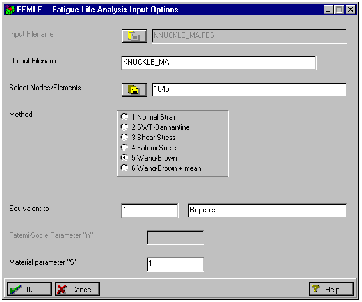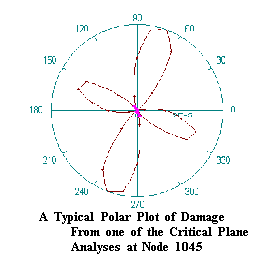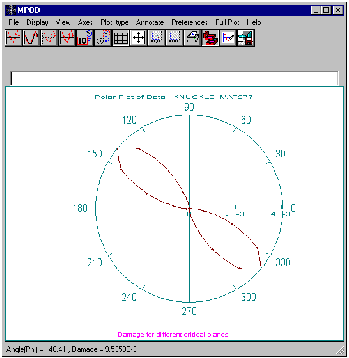XXXXXXXXXXXXXXXXXXXXXXXXXXXXXXXXXXXXXXXXXXXXXXXXXXXXXXXXXXXXXXXXXXXXXXXXXXXXXXXXXXXXXXXXXXXXXXXXXXXXXXXXXXXXXXXXXXXXXXXXXXXXXXXXXXXXXXXXXXXXXXXXXXXXXXXX''"> Concluding Remarks
This exercise has dealt with a FE model with complex geometry subject to multiple loading inputs. The critical location was determined and a stress state evaluation was done to determine the amount of multiaxiality at the critical location. From this the validity of the fatigue analysis was determined based on the assumption of a uniaxial stress state. Had the loading been proved to be other than uniaxial the following approaches must be taken:
Accounting for Proportional Loading
Proportional loading, which means ae is non-zero but constant and the stress tensor mobility is minimal, can be accounted for on the Solution Params... form by setting the Biaxiality Correction method. Two methods exist, both of which modify the uniaxial material properties using ae.
1. Material Parameter: The Material Parameter method basically makes a new set of parameters (E, K' and n') for each state of stress. For example, Young’s Modulus becomes E* = E/(1-νae). It assumes the ratio of the principal strains remains fixed and that the von Mises stress and strain yield criteria obey the cyclic stress strain curve postyield. It is only valid to use with a maximum strain based combination parameter (Max. Abs. Principal).
2. Hoffman-Seeger: The Hoffmann-Seeger method makes the same basic assumptions, but makes the Neuber correction in equivalent stress-strain space. It has the advantage that it predicts all the principal stresses and strains and can therefore be used in conjunction with any equivalent stress or strain combination parameter.
See the MSC Fatigue User’s Guide for more details on these correction methods.
Accounting for Non-proportional Loading
There is, as yet, no general agreement about how to fully deal with non-proportional loadings - it is still a major research topic. A full multiaxial fatigue analyzer is included as part of MSC Fatigue however, and can be run externally once an initial global location fatigue analysis has been run (at least through the translation stage, i.e., the creation of a jobname.fes file). The module is called FEMLF and can be invoked from the system prompt using the symbol, femlf or from the Tools pull-down in Pre & Post.

This module has a few different methods and you are referred to the MSC Fatigue User’s Guide for detailed description of its usage. In general, fatigue life estimation from a non-proportional loading situation can only be properly determined by doing a critical plane analysis. This entails doing multiple analyses at representative angles of φp. A new rainflow cycle counting procedure is also adopted which takes into consideration that a cycle may begin on one plane and close on another. The notch correction procedure of correcting for plasticity also becomes complicated and uses a kinematic hardening model (the equivalent of using Neuber and Masing’s hypothesis for a uniaxial stress state). It is an advanced subject and beyond the scope of this text. But procedures do exist in MSC Fatigue.
Note: | As of the release of this version of MSC Fatigue, the multiaxial analyzer, FEMLF, although available, has not been fully validated. This is mainly due to the fact that the theoretical basis is not well established or fully accepted in the circles of fatigue experts. For this reason a number of methods are included in FEMLF. |
It is best not to assume a non-proportional loading situation just because the external loading and geometry are complex:
1. First assume a uniaxial stress state and perform the fatigue analysis.
2. Run a biaxiality analysis to produce the stress state parameters needed to evaluate multiaxiality.
3. Evaluate the biaxiality parameters at the critical locations to determine if any corrections need to be made for proportional or non-proportional loading.
The evaluation criteria for proportional or non-proportional loading is as such:
1. If ae is close to zero and φp is constant, uniaxial assumptions stand.
2. If ae is non-zero but constant and φp is constant, a state of proportional loading exists. Compensation can be made by using the Material Parameter or Hoffman-Seeger methods to modify the uniaxial material properties.
Hint: | For ae=0 Signed Tresca, Signed von Mises and Max. Abs. Principal should give close to the same results. If ae is negative, Max. Abs. Principal is the best choice. If ae is positive, Signed Tresca is the best choice. These comments apply to the crack initiation approach. If using stress life it is best to stick with Max. Abs. Principal. |
3. If neither ae or φp are constant but vary significantly above the stress gate, a state of non-proportional loading exists. Compensation must be made by using the full multiaxial fatigue analyzer, FEMLF to do critical plane analysis.
Note: | Critical plane analyses can be computationally expensive since they requires multiple calculations at every location. |
Run FEMLF from a system or DOS prompt if you wish and select Crack initiation life analysis. Accept the jobname, knuckle_ma as default and enter 1045 as the node of interest. Remember this is the node on the steering arm that appeared to have some degree of multiaxiality. Accept all the defaults and click OK to run the analysis. A summary form appears. Accept it by clicking OK to go to the Display Menu. From here you can plot cycle/damage histograms or damage polar plots to see the results of the critical plane analysis. Try rerunning the analysis at this node for all the different methods to see the variability. The table below summarizes the results.
Multiaxial Method | Life |
Uniaxial Solution | ~97,300 |
Normal Strain | ~106,000 |
SWT-Bannantine | ~316,500 |
Shear Stress | ~18,500 |
Fatemi-Socie | ~27,000 |
Wang-Brown | ~30,500 |
Wang-Brown + mean | ~26,000 |
Rerun the analysis using Node 7977. This was the critical node from our uniaxial analysis. The biaxiality analysis showed us that the most popular angle, φp, at most time points for values above the stress gate was around -40 degrees. This means that if we were to perform a critical plane analysis we would see the majority of the damage at -40 degrees in a polar plot. This is indeed the case as shown to the right.




